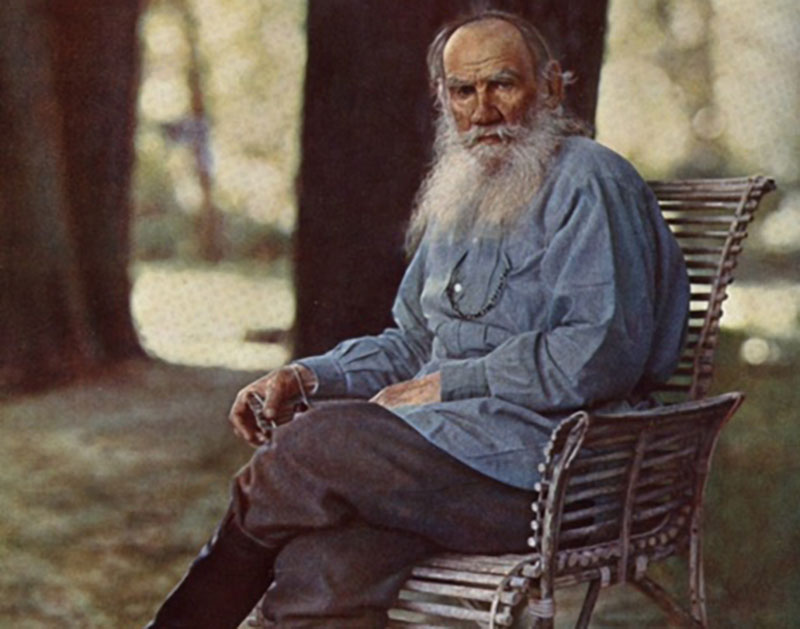Bread, Security, and Freedom

Fortunately for the reader, this article will not be 1,225 pages long, as was the first full edition of Leo Tolstoy’s historical novel, War and Peace, published in 1869. Tolstoy’s great work, however, is not irrelevant to understanding Russia and the Russian people today. The time-frame of his historical “fiction” is centered on real European events from 1805 to 1820 relating to Napoleon’s war with and invasion of Russia. Over 160 of the people mentioned in the “novel” were not fictional but real people. The events and times brought great suffering to the Russian people, but they overcame and triumphed over their suffering and their French invaders.
Tolstoy was a Christian and a realist. Many of the chapters of War and Peace were not narrative. They were Tolstoy’s philosophical grappling with war, power, tragedy, suffering, moral dilemmas, and survival that still permeate the nobler understanding of Russian suffering.
The Russian Empire, which included Ukraine, lasted until 1917 and the great suffering of 70 years of Communist rule. This suffering was multiplied by World War II, called by the Russians, the Great Patriotic War. This extremely costly triumph over brutal Nazi invaders is celebrated annually on May 9 with a great victory parade in Moscow’s Red Square. This suffering and eventual triumphant victory have become ingrained in the Russian psyche. It is their Iliad.
The Russian Academy of Sciences estimated that the population of the USSR was 197 million in 1941. According to this 1993 report, at least 26.3 million Soviets died in World War II, 8.7 million military and 17.6 million civilian deaths. According to Vladimir Putin, 70 percent of the total deaths, 18.7 million were in the present Russian Federation. Proportionally, Ukraine suffered even more severely with 1.65 military, 3.7 million non-Jewish, and 1.5 million Jewish civilians perishing—at total of 6.85 million of a population of 37 million. By comparison, U.S. military deaths were 406,000, and civilian deaths were 12,000 out of 134 million people. Not even U.S. Civil War deaths estimated at 880,000 of 33 million, which included at least 50,000 Confederate civilians and 80,000 Southern slaves, who died of famine and disease as a result of displacement, come near the suffering of Russia and Ukraine during the Great Patriotic War.
Putin and the Russian General Staff believe the Russian tolerance for suffering gives Russia a considerable advantage over its primary rival, the United States. The ability to endure suffering and casualties and outlasting the U.S. is part of their military doctrine. But the Ukrainians are at least their equal in their historical endurance of suffering.
Russians and Americans do not think alike. Putin is a Russian.
As I discussed in my February 27 article on “Putin’s War on Ukraine,” many Americans, especially in the past, would choose freedom over security, and even over peace and bread. Tough reality has forced most Russians to place bread and security over freedom, giving them a higher tolerance for reduced freedoms and ruthless power to maintain stability and security.
The United States, its NATO allies, Ukraine, and Russia are party to the Geneva Conventions that prohibit deliberate war against civilians or mistreatment of POWs. Putin has not rejected these, but Putin and Russian military doctrine may have quite a different take on them than the U.S. and its NATO allies.
The vision of war against Ukraine embraced by Putin and Russian military doctrine may be close to that made most famous by Union General William T. Sherman during the American Civil War. Sherman practiced “hard war” or “total war” on Confederate civilians and their properties to bring pressure on the Confederate forces and government to end the war as quickly as possible. Sherman’s later justification was that ending the war quickly saved lives and property. The U.S. was not signatory to the Geneva Conventions during that war.
Here are a few quotes from Sherman that are short of holocaustic barbarism but do not come near meeting Christian Just War Guidelines. Most Americans do not realize that President Lincoln, Secretary of War Stanton, and several Union generals approved of and practiced “total war” policies.
“This war differs from other wars, in this particular. We are not fighting armies but a hostile people and must make old and young, rich and poor, feel the hard hand of war.”
“War is at best barbarism. Its glory is all moonshine…War is hell.”
“Until we can repopulate Georgia it is useless to occupy it, but utter destruction of its roads, houses, and people will cripple their military resources. By attempting to hold the roads we will lose a thousand men monthly and will gain no result. I can make the march and make Georgia howl.”
By the end of the American Civil War, one of every four white Southern men had been killed or died of wounds or disease. Over 40 percent of Southern private property, including homes,, businesses, livestock, and crops had been destroyed.
In 1870, Union General Philip Sheridan was assigned as a guest of the King of Prussia to observe the Franco-Prussian War. At a dinner honoring Prussian Chancellor Otto von Bismarck, he shared some of his military experience and philosophy with Prussian Army officers:
“First, deal as hard blows to the enemy’s soldiers as possible, and then cause so much suffering to the inhabitants of the country that they will long for peace and press their government to make it…Nothing should be left to the people but eyes to lament the war.”
The Prussians were shocked, but later Nazi policy against the Russians and Ukrainians made such conduct policy.
There are cases in which there is a tradeoff favoring “hard war” over a longer and presumably more bloody and destructive war. In 1945, President Harry Truman had to make such a choice to use nuclear weapons or sacrifice the lives of hundreds of thousands of American soldiers.
In 2014, the Russian people supported Putin’s unlawful annexation of Crimea. Over the last 20 years Putin’s approval rating has averaged a remarkably high 79 percent but reached its all time high with 89 percent following the annexation. Most Americans do not know the historical background. In 1954, the Supreme Soviet arbitrarily transferred Crimea from Russia to Ukraine because of proximity, although 71 percent of the population was Russian and only 22 percent was Ukrainian. In 2014, it was 68 percent Russian and only 16 percent Ukrainian and 10 percent Muslim Tatars. Crimea has always been a favorite Russian vacation spot. According to the internationally respected Russian Levada Center polling agency, Putin’s buildup of Russian forces on the border in February actually increased Putin’s popularity, which had fallen to 61 percent, back to 69 percent. He is viewed as a “strong” leader, which Russians like.
But actual war and especially ruthlessly or carelessly inflicted civilian casualties appear to be making a difference. Fully 83 percent of Russians have a favorable view of Ukrainians, and 51 percent say Ukraine should be independent but friendly. The popular narrative espoused by Putin and the people is that Russia is a besieged fortress constantly fending off Western attacks. On the February 24 poll, half of Russians blamed the current crisis on the U.S. and NATO; only 4 percent believe Russia is responsible.
But on March 5, at least 176 Russian Orthodox priests signed a statement saying the people of Ukraine “must make their own choices by themselves, not at the point of assault rifles and without pressure from either West or East.” On March 1, at least 150 Russian Orthodox clerics had called for an immediate stop to the ongoing war in Ukraine. Patriarch Kirill, in deference to Putin’s strong support for the Russian Orthodox Church for over two decades, has not signed the letter. Other You-Tube communications indicate that both Russian and Ukrainian evangelical groups are strongly against the war and highly upset with Russian military actions endangering civilians. Some on the street videos indicated that many people were unwilling to believe that Putin would bomb civilians. However, it is clear that Putin is now falling out of favor with many Orthodox and Evangelical believers.
Putin has been preparing to defend against NATO financial and monetary sanctions since 2014. Nevertheless, the Russian stock market and Russian index funds are down 83 percent since mid-February
Ukraine is about 17 percent native-Russian speaking. Roughly the same 17 percent identify as Russian Orthodox. Almost 100 percent of Ukrainian adults speak Russian as a first or second language. The ethnic Russians are concentrated in eastern Ukraine. This division could easily be seen on Russian presidential and parliament election maps until Volodymyr Zelenskyy’s overwhelming election sweep in May 2019. Putin may have been expecting an easy sweep into Kyiv with considerable Russian sympathizers. If so, this was a major miscalculation. Another indication that Ukrainians of both Ukrainian and Russian ethnic background do not want to be subject to Russia is the battle for Ukraine’s second largest city, Kharkiv (Russian Kharkov), with 1.4 million people only 20 miles from the Russian border in eastern Ukraine. The Russians have made a major effort to take the city but have been unsuccessful even though Kharkiv is Russian speaking and 62 percent are Russian ethnics. Yet being under Russian dominance is worth fighting hard against. Perhaps they see that Belarus is not prospering as a friend of Russia.
The Russian military strategy is probably to occupy most of Ukraine east of the Dnieper River and along the Black Sea and place Kyiv under siege. They do not have enough manpower to occupy many cities, but they will surround and isolate them for effective siege. Urban warfare is a high casualty meat-grinder most competent generals would avoid if at all possible. They will starve unoccupied cities of food, medicines, and necessities until they surrender. It is most likely the Russians would negotiate to end the war, if they can gain all of Ukraine east of the Dnieper and the Black Sea coast. But Putin cannot tie such a large portion of the Russian Army up in Ukraine for long. It would be a financial and logistical bust, leaving the rest of Russia open to deteriorating national security problems. Bombarding Kyiv by air and artillery inflicting mass casualties to force its surrender could be the ruin of Putin’s political career and Russian political stability rather than Ukraine’s.
The Russian mindset in adversity is to never give up. But the Ukrainians have the same Slavic qualities. Making war against their brothers is a losing proposition that will only weaken Russia.
The United States and NATO should supply Ukraine with defensive weapons, ammunition, and humanitarian supplies and aid by covert means and wait for Russian troops to leave. Meanwhile, NATO force levels in the Baltic and around the Black Sea should upgraded and increased.
Labeling Putin an irrational, reckless, and delusional thug may make some people feel virtuous, but it will not bring peace or help the Ukrainian people. Failing to understand and respect your enemies’ strengths is a dangerous blindness. Calling for assassinations and regime changes of Russian leaders on national media make real solutions impossible and disastrous consequences probable.









 Mike Scruggs is the author of two books: The Un-Civil War: Shattering the Historical Myths; and Lessons from the Vietnam War: Truths the Media Never Told You, and over 600 articles on military history, national security, intelligent design, genealogical genetics, immigration, current political affairs, Islam, and the Middle East.
Mike Scruggs is the author of two books: The Un-Civil War: Shattering the Historical Myths; and Lessons from the Vietnam War: Truths the Media Never Told You, and over 600 articles on military history, national security, intelligent design, genealogical genetics, immigration, current political affairs, Islam, and the Middle East. 


